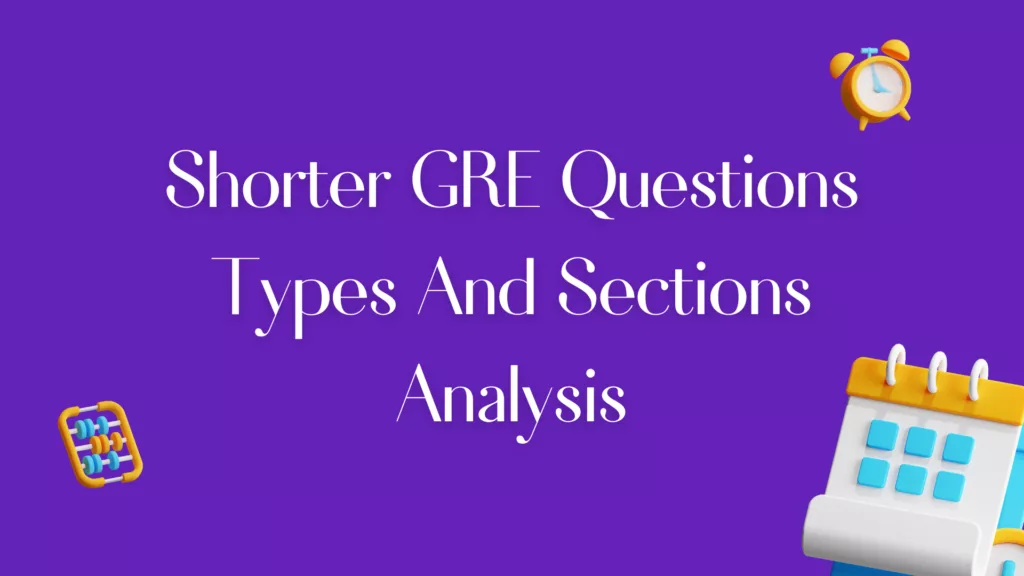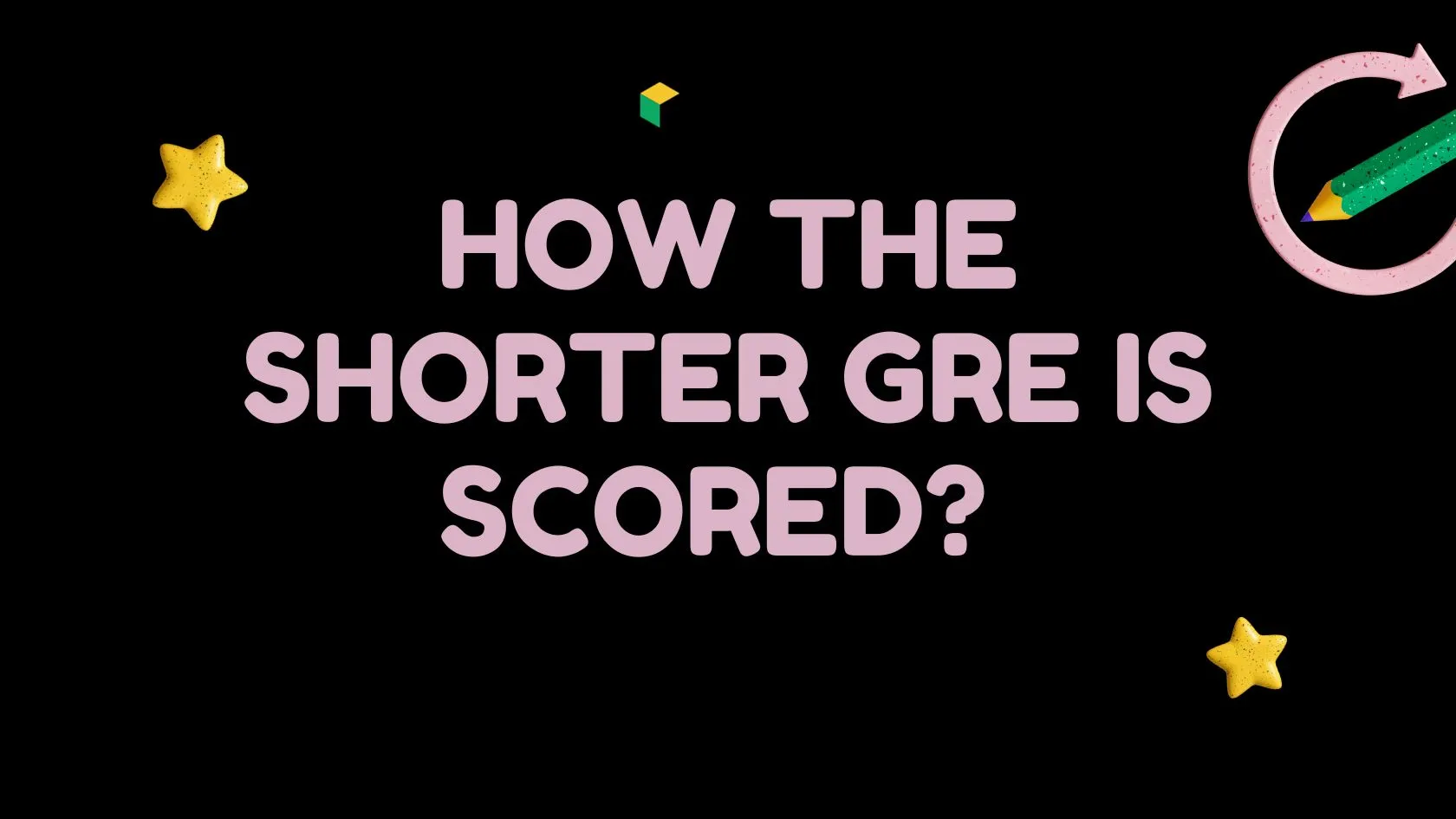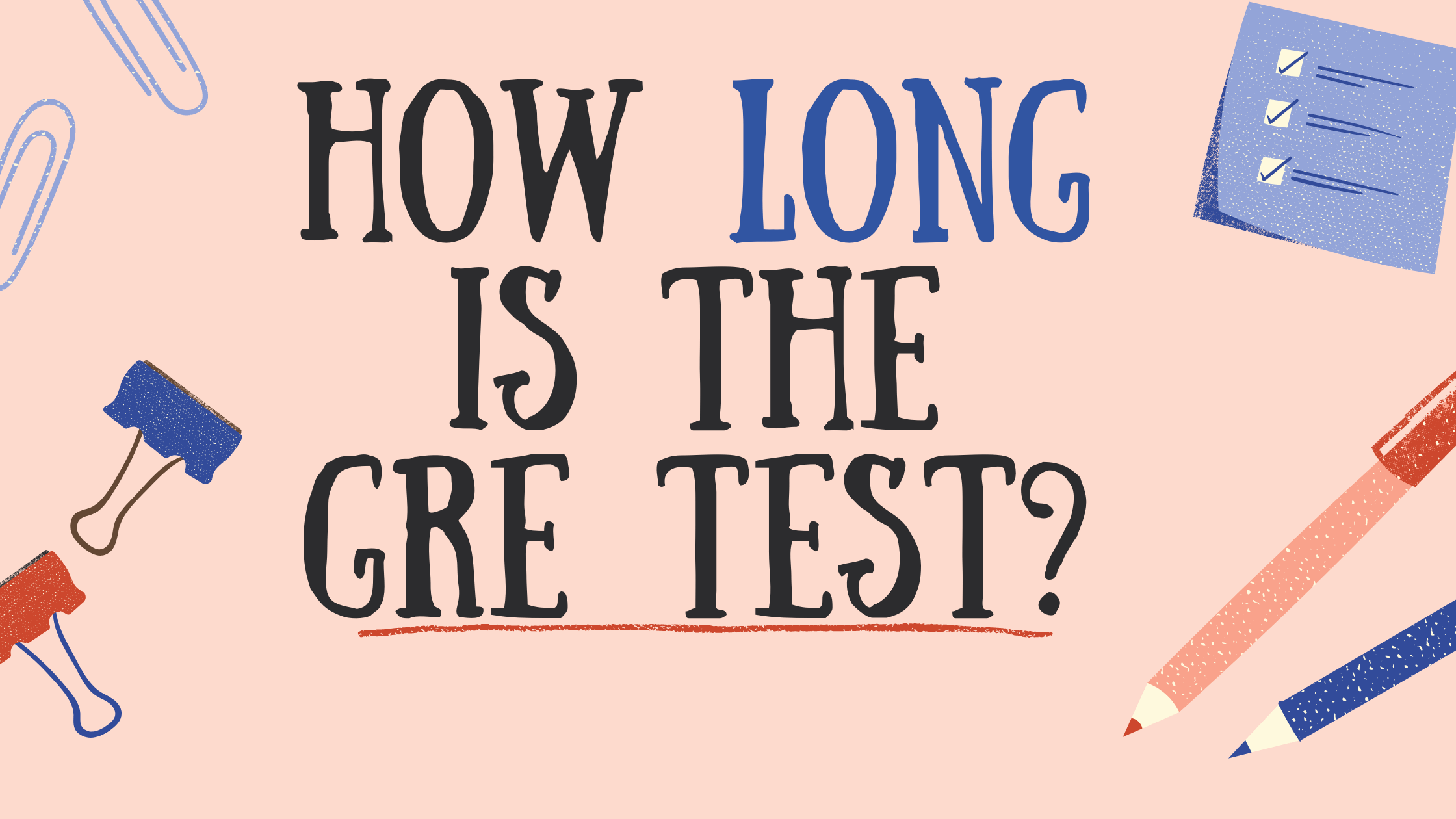In 2023, the GRE test significantly changed to the newer, shorter version. Without knowing the shorter section details, GRE preparation would be confusing. A few months ago, ETS announced the shorter GRE test and significant changes applicable from September 22. This article will analyze question types, section analysis, and curriculum changes in depth.
The newer GRE has undergone some changes, including section details, question types, number of questions per section, scoring algorithm, and every vital point you need to know about the shorter GRE.
Most crucial changes in the new shorter GRE curriculum:
- Longer Reading Comprehension passages were removed from the entire GRE test.
- Data Integration (DI) Questions were removed from Quantitative Section 2, whereas they would be available in Quantitative Section 1.
- The Argument essay was removed.
Let’s dive right in and guide you further on the recent changes in the shorter GRE.
An Overview of the GRE Questions Per Section
The ETS GRE exam, also known as the GRE general test, assesses and measures your abilities and skills across three main sections.
- Verbal Reasoning
- Quantitative Reasoning
- Analytical Writing Assessment (AWA)
Each verbal and quantitative section will have two sections, whereas AWA will have only one section.
Shorter GRE Section Analysis
GRE is a section adaptive test, which means the second section’s difficulty will change based on your performance in the first section. The GRE consists of two separately timed tasks for each section, which adapt based on your performance. If you perform well in the first section, you will get a hard-level second section, and your scores will earn bonus points for getting a hard, challenging section.
Similarly, you will get a penalty if you get an easy to medium-level section. For an in-depth analysis of shorter GRE scoring, read how GRE scoring works on the shorter GRE test.
Sections Breakdown
- Section 1: 12 Questions
- Section 2: 15 Questions
- Total: 27 Questions
The GRE is divided into sections with a specific number of questions and time limits for each.
| Section Names | Questions | Time (in minutes) |
|---|---|---|
| Analytical Writing Assessment | 1 | 30 minutes |
| Verbal Reasoning Section 1 | 12 | 18 minutes |
| Quantitative Reasoning Section 1 | 15 | 21 minutes |
| Verbal Reasoning Section 2 | 12 | 23 minutes |
| Quantitative Reasoning Section 2 | 15 | 26 minutes |
| Total Time | 55 | 1 hour and 58 minutes |
Verbal Reasoning
The verbal reasoning section of the new shorter GRE consists of 27 questions. The questions on the GRE Verbal Reasoning section include Text Completion, Sentence Equivalence, Argument-Based Passages, and Reading Comprehension. The first section has 12 questions, and the second consists of 15, making a total of 27 verbal questions; your time limit for answering these questions is 41 minutes. This section is based on four GRE Verbal types of questions;
- Text Completion
- Sentence equivalence
- Argument-Based Passages / Critical Reasoning
- Reading Comprehension
Section 1
- Text Completion (3 Questions)
- Text Completion (1 Blank): Fill one blank in a sentence with the right word.
- Text Completion (2 Blanks): Fill two blanks in a sentence with the correct words that make sense.
- Text Completion (3 Blanks): Fill three blanks in a sentence to create a logical and complete sentence.
- Sentence Equivalence (4 Questions)
- Sentence Equivalence: Pick two words that create sentences with similar meanings in a blank sentence.
- Sentence Equivalence (2 Blanks): Select two words that make a sentence with two blanks have similar meanings.
- Sentence Equivalence (2 Blanks): Choose two words for a sentence with one blank to maintain similar meanings.
- Sentence Equivalence: Choose two words to fill a blank in a way that makes the sentence have similar meanings.
- Argument Based Passages (2 Questions)
- Argument-Based Passages (Weaken): Find answer choices that make an argument look weaker or less convincing.
- Argument-Based Passages (Support): Choose answer options that make an argument stronger and more logical.
- Reading Comprehension (3 Questions)
- Reading Comprehension (Short Passage): Read short passages and answer questions about the main ideas, details, and author’s tone.
- Reading Comprehension (Short Passage – Vocab): Like the previous type, focus on short passages but pay attention to vocabulary inferences and word usage.
- Reading Comprehension (Short Passage): Again, read short passages, but this time, focus on understanding the content and nuances of the text.
Section 2
- Text Completion (4 Questions)
- Text Completion (1 Blank): Fill in a sentence’s single blank with the right word to make it meaningful.
- Text Completion (1 Blank): Similar to the first type, fill in a sentence’s one blank with the correct word for coherence.
- Text Completion (2 Blanks): Choose words to fill two blanks in a sentence logically.
- Text Completion (3 Blanks): Select words for three blanks in a sentence to make it coherent.
- Sentence Equivalence (3 Questions)
- Sentence Equivalence: Choose two words for one blank that mean the same.
- Sentence Equivalence: Select two words for one blank with the same meaning.
- Sentence Equivalence: Continue choosing two words for one blank with the same meaning.
- Argument Based Passages (4 Questions)
- Argument-Based Passages (Support): Pick answers that strengthen the argument.
- Argument-Based Passages: Answer questions about logical reasoning, with various types (e.g., Strengthen, Weaken).
- Argument-Based Passages (Weaken): Find answers that weaken the argument.
- Argument-Based Passages (Weaken): Find answers that weaken the argument’s credibility.
- Reading Comprehension (4 Questions)
- Reading Comprehension (Short Passage): Read short passages and answer questions about what you read.
- Reading Comprehension (Short Passage – Vocab): short passages that focus on vocabulary in context.
- Reading Comprehension (Short Passage – Vocab): short passages that test vocabulary.
- Reading Comprehension (Short Passage – Function): Focus on understanding the purpose of a passage in the context of the text.
| Section 1 | Questions | Section 2 | Questions |
|---|---|---|---|
| Text Completion | 3 | Text Completion | 4 |
| Sentence Equivalence | 4 | Sentence Equivalence | 3 |
| Argument-Based Passages | 2 | Argument-Based Passages | 4 |
| Reading Comprehension | 3 | Reading Comprehension | 4 |
| 12 | 15 |
Quantitative Reasoning
The Quantitative Reasoning section analyzes your basic math and problem-solving proficiency, measuring your quantitative understanding and math application. The Quantitative Reasoning section also tests your data analysis skills, requiring you to interpret and analyze numerical data. You’ll see 12 Quant questions in the first part and 15 Quant questions in the second part, which includes quantitative comparison questions, multiple-choice questions, and numeric entry questions, which adds up to 27 Quantitative questions. You have 47 minutes to answer them all. This section is based on four GRE Math question types.
- Quantitative Comparison
- Multiple Choice Question – 1 Choice
- Numeric Entry
- Multiple Choice Question – 1+ Choices
An on-screen calculator is available during the Quantitative Reasoning sections to assist with various mathematical concepts and problem-solving strategies.
Section 1
- Quantitative Comparison (4 Questions)
Quantitative Comparison: Test-takers compare two quantities to determine which is more significant or if they are equal, demonstrating their ability to analyze and compare numerical values.
- Multiple Choice Question (MCQ) 1 Choice (5 Questions)
Multiple Choice Question – 1 Choice: A straightforward multiple-choice math question with only one correct answer choice.
- Numeric Entry (2 Questions)
Numeric Entry: Test-takers provide a numeric answer, showcasing their ability to calculate and enter numerical solutions.
- Multiple Choice Question (MCQ) 1+ Choices (1 Questions)
Multiple Choice Question – 1+ Choices: Multiple-choice math questions where there may be one or more correct answer choices, testing problem-solving skills.
Section 2
- Quantitative Comparison (5 Questions)
Quantitative Comparison: Test-takers compare two quantities to determine which is greater or if they are equal, showcasing their ability to analyze and compare numerical values.
- Multiple Choice Question (MCQ) 1 Choice (7 Questions)
Multiple Choice Question – 1 Choice: A standard multiple-choice math question with one correct answer choice.
- Numeric Entry (1 Question)
Numeric Entry: Test-takers provide a numerical answer, demonstrating their ability to calculate and input numerical solutions.
- Multiple Choice Question (MCQ) 1+ Choices (2 Questions)
Multiple Choice Question – 1+ Choices: Multiple-choice math questions with one or more correct answer choices, testing problem-solving skills.
| Section 1 | Questions | Section 2 | Questions |
|---|---|---|---|
| Quantitative Comparison | 4 | Quantitative Comparison | 5 |
| Multiple Choice Question – 1 Choice | 5 | Multiple Choice Question – 1 Choice | 7 |
| Numeric Entry | 2 | Numeric Entry | 1 |
| Multiple Choice Question – 1+ Choices | 1 | Multiple Choice Question – 1+ Choices | 2 |
| 12 | 15 |
Analytical Writing
The analytical writing section, or AWA, is by far the most important section, which assesses your analytical writing skills, critical thinking, examination of complex issues, wordplay, and your command of the language through your arguments.
The GRE Analytical Writing section includes two essay tasks that measure your ability to craft clear and concise analyses in response to prompts.
This section consists of only one type of essay, the Analyze an Issue task, which is part of the GRE Analytical Writing section.
- Issue Essay
One Essay task
In the analytical writing section, you will have an essay task known as the “Analyze an Issue” task, where you will analyze written material and respond according to the instructions. You’ll be provided with a statement of opinion to analyze an issue, and your time limit for answering this question is 30 minutes.
Read on: Understanding how the new shorter GRE is scored









